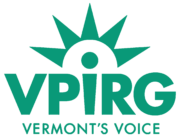The Vermont state Senate gave its final approval today to legislation that would update and substantially expand the scope of the state’s beverage redemption program, commonly known as the Bottle Bill. The vote in favor of H.175 was 17-13 and the bill now must return to the House for possible concurrence before it can go to the governor.
VPIRG has been one of the leading proponents of modernizing the Bottle Bill for many years. We applaud the passage of this legislation and want to highlight several of its key attributes:
- Promotes clean air, clean water, and a cooler climate by collecting hundreds of millions more containers each year to be recycled into new products again.
- Makes further improvements to the current redemption system by adding more convenient opportunities for consumers to return containers for redemption.
- Eases the burden on businesses by exempting small retailers from the program and dramatically reducing the sorting requirements for redemption centers.
“The Bottle Bill has been Vermont’s most successful recycling and anti-litter program for the past 50 years,” said Marcie Gallagher, VPIRG’s environmental advocate. “But many of the most popular beverages today didn’t exist in 1972 when the program was established. It’s time to update the law as nearly every other state with a bottle deposit program has done.”
Vermont’s Bottle Bill covers about 46 percent of beverages sold here. By contrast, Maine’s program has been updated so that it covers more than 90 percent of beverages.
It’s estimated that over ten billion containers have been recycled through Vermont’s Bottle Bill program since it was first implemented. The system has consistently maintained redemption rates of 75%or greater, even when national recycling rates have plummeted. And while virtually every container returned for redemption through the Bottle Bill is recycled into another product (often a new beverage container), the same cannot be said for much of the material Vermonters dutifully place in the recycling bins each week.
For instance, the Chittenden Solid Waste District (CSWD), which processes about half of the glass collected for recycling in the state, was caught illegally dumping the material several years ago. In total, CSWD improperly dumped at least 18,000 tons of glass intended for recycling because it was too contaminated with other material to market. CSWD ended up paying a $400,000 fine to settle the case with the Attorney General.
“There is no question that from an environmental standpoint, the Bottle Bill is the best way to collect and recycle beverage containers,” said Gallagher.
Vermonters seem to agree in overwhelming numbers. In statewide polling conducted for VPIRG last year by Lincoln Park Strategies, 88 percent of Vermonters expressed support for the Bottle Bill and 83 percent favored expanding the scope of the law to new containers such as water bottles, sports drinks, and wine.
While differing versions of the House and Senate proposals must still be reconciled before the Legislature adjourns, both versions would update the law to cover almost twice as many beverages as the Bottle Bill now covers. Currently, the program includes carbonated beverages (like beer and soda) and liquor.
New beverages that would be covered by the law beginning in January 2025 include water bottles, hard cider, sports drinks and more. Beginning in January 2026, wine bottles would be included in the program.
The updated law would also ensure that all communities with 7,000 or more people are serviced by a redemption center, and there would have to be at least three redemption locations per county.
“We’ve been fighting to update the Bottle Bill for decades,” said Paul Burns, executive director of VPIRG, who noted that both VPIRG and the Bottle Bill came to be in 1972. “This legislation finally delivers for the environment, for consumers, and for small businesses in the state.”
Beverage redemption programs are increasingly popular worldwide, particularly as nations grapple with the mounting problem of plastic pollution. Approximately 600 million people now live in areas covered by Bottle Bills. That number has doubled in the last five years.
# # #

